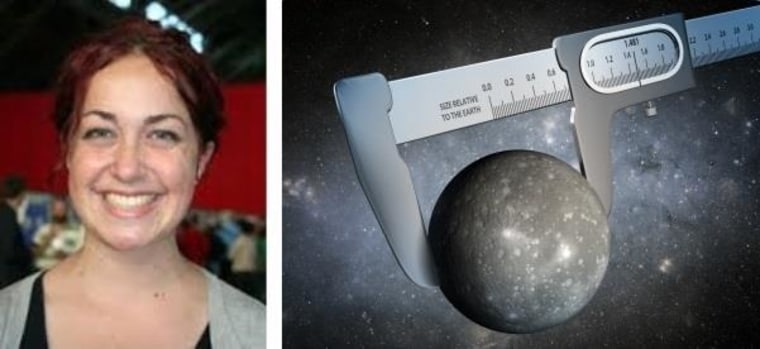Another day, another planet: It used to be that the mere discovery of one world around a distant star was enough to grab the headlines — but now the spotlight is pulling back to shine a light on the bigger questions in exoplanetology: Statistically speaking, how many planets of what sizes could be found around which kinds of stars? How likely is it that life has taken root elsewhere in the universe?
Those are the questions that increasingly engage the attention of Sarah Ballard, a self-described "exoplaneteer" at the University of Washington. Ballard already has been involved in some of the field's most noteworthy discoveries, ranging from the detection of an "invisible" planet known as Kepler-19c to the ultra-precise measurement of a different world called Kepler-93b.
Now she sees exoplanetology going in a new direction.
"I think it will always be important to put individual worlds under a microscope, especially the few, such as Kepler-93, which are really amenable to detailed study like that," she told NBC News. "But the vast majority of studies are going to be about the bulk properties of planets. ... What does 'typical' look like? Is the solar system typical? The scope of that question is beyond the study of any one planet."
Ballard discusses the future of exoplanetology during Wednesday's installment of "Virtually Speaking Science," airing at 8 p.m. ET via Blog Talk Radio and in the Second Life virtual world. She came to Seattle as a NASA Carl Sagan Fellow after earning her degrees in astrophysics from Berkeley and Harvard — and has been hunting planets for several years, using readings from NASA's Kepler and Spitzer missions.
The way she sees the planet quest, small is beautiful.
"We now know that small stars host planets in profusion," she said. Researchers suspect that virtually every star that's the size of our sun or smaller has at least one planet, and that the nearest habitable planet beyond our solar system is probably orbiting one of those dwarf stars.
"The question is, what would life be like around small stars like that?" Ballard said.

The statistics suggest that half of the stars tend to have multiple planets in stable, roughly circular orbits — while the other half has relatively few planets, or planets in extremely inclined or elliptical orbits. "I backed this out from the Kepler statistics as a whole, so it's a study of bulk yields of planets from Kepler, instead of focusing my attention on one planet," Ballard said.
Life seems more likely to arise on planets in stable orbits, where the temperatures allow for year-round liquid water rather than a frozen-to-boiling range. And that has implications for the planet quests to come.
"If you have only one or two planets on which you'll lavish hundreds of hours of time with the James Webb Space Telescope, then you have to think very carefully about how to allocate those hours," Ballard said. "Which world should you look at, because you won't know for years whether or not it was the right world."
No one can accuse Ballard of not thinking ahead: She's already looking beyond Kepler to NASA's next big planet-hunting probe — known as the Transiting Exoplanet Survey Satellite, or TESS. In contrast to Kepler, which looked for faraway alien worlds in a small patch of the sky, TESS is designed to focus on thousands of the nearest stars. The most promising candidates from TESS' all-sky survey will probably end up on the Webb Space Telescope's list for the 2020s.
And then what? Ballard hopes we'll eventually send a spacecraft on a decades-long mission to a habitable exoplanet.
"All of that relies upon TESS identifying such a planet, then the James Webb Space Telescope characterizing its atmosphere and determining that it does have the signature of life," she said. "Then, in my wildest dreams, the follow-up on that would be sending a probe to that planet. ... Whether that happens in my lifetime, I can only hope."
Extra credit: A brand-new example of statistical exoplanetology came to light on Wednesday, when astronomers reported that 40 to 50 percent of the stars that host Kepler's planetary candidates are actually binary stars. "It's interesting and exciting that exoplanet systems with stellar companions turn out to be much more common than was believed even just a few years ago," the research team's leader, Elliott Horch of Southern Connecticut State University, said in a news release. The study, which combined Kepler data with observations using the WIYN Telescope in Arizona and the Gemini North Telescope in Hawaii, has been accepted for publication in The Astrophysical Journal.
Not that long ago, some astronomers doubted that binary stars could host planets like Tattooine in the "Star Wars" saga. Now it's the conventional wisdom. That's something else to talk about during the "Virtually Speaking Science" session.
University of Washington exoplanetologist Sarah Ballard will discuss the future of the search for alien worlds with NBC News science editor Alan Boyle at 8 p.m. ET Wednesday on "Virtually Speaking Science," an hourlong talk show that airs on BlogTalkRadio and in the Exploratorium's Second Life virtual auditorium. If you miss the live show, never fear: You can catch up with the podcast via BlogTalkRadio or iTunes. Last month's show featured Emily Lakdawalla, Rod Pyle and Marc Kaufman talking about the past and future of Mars exploration.